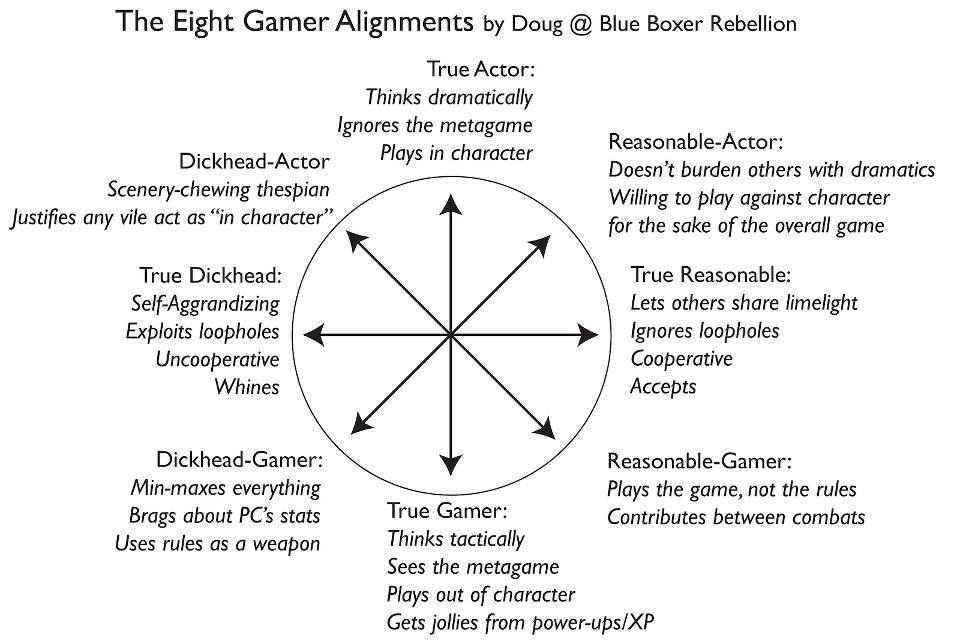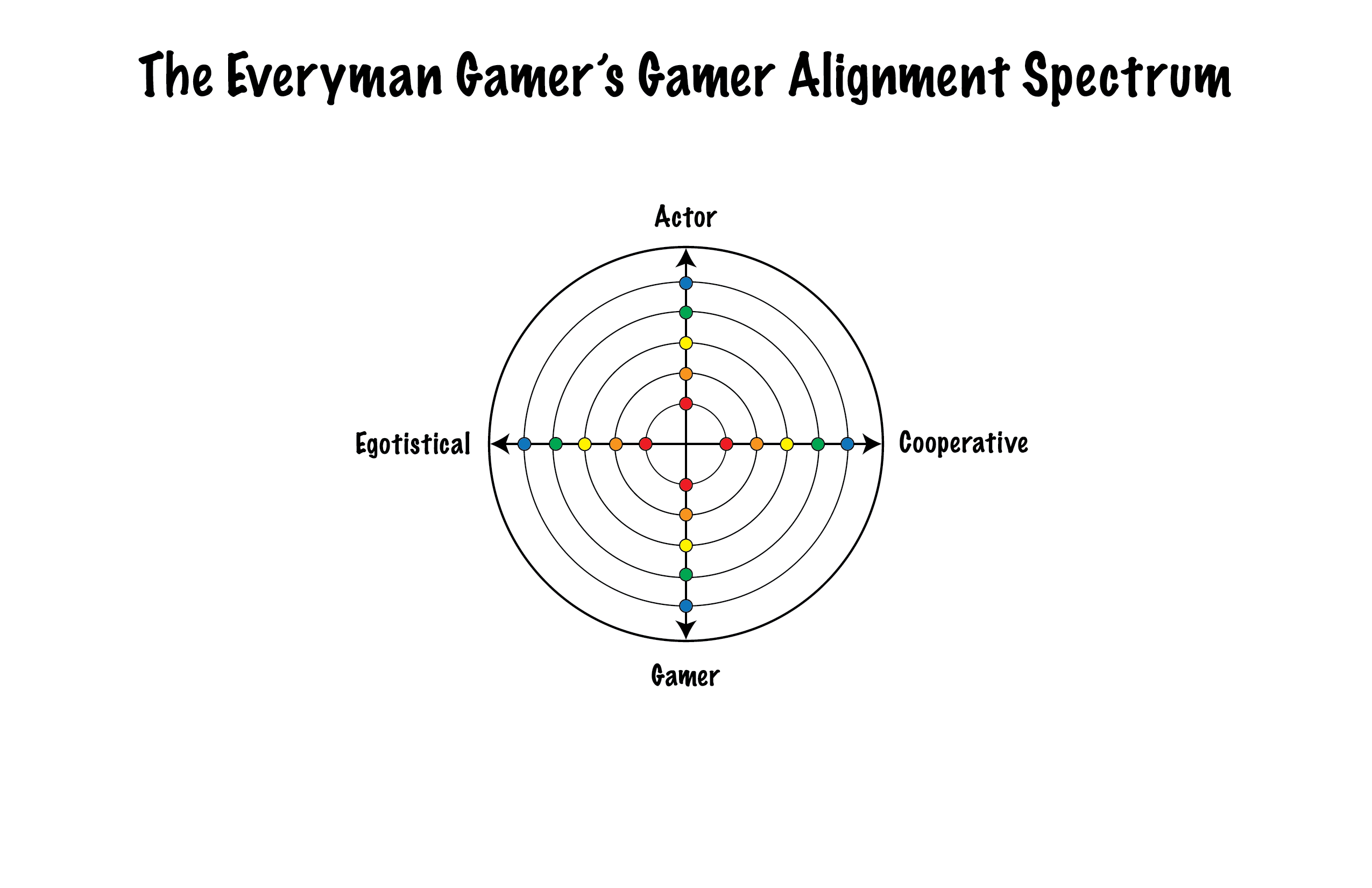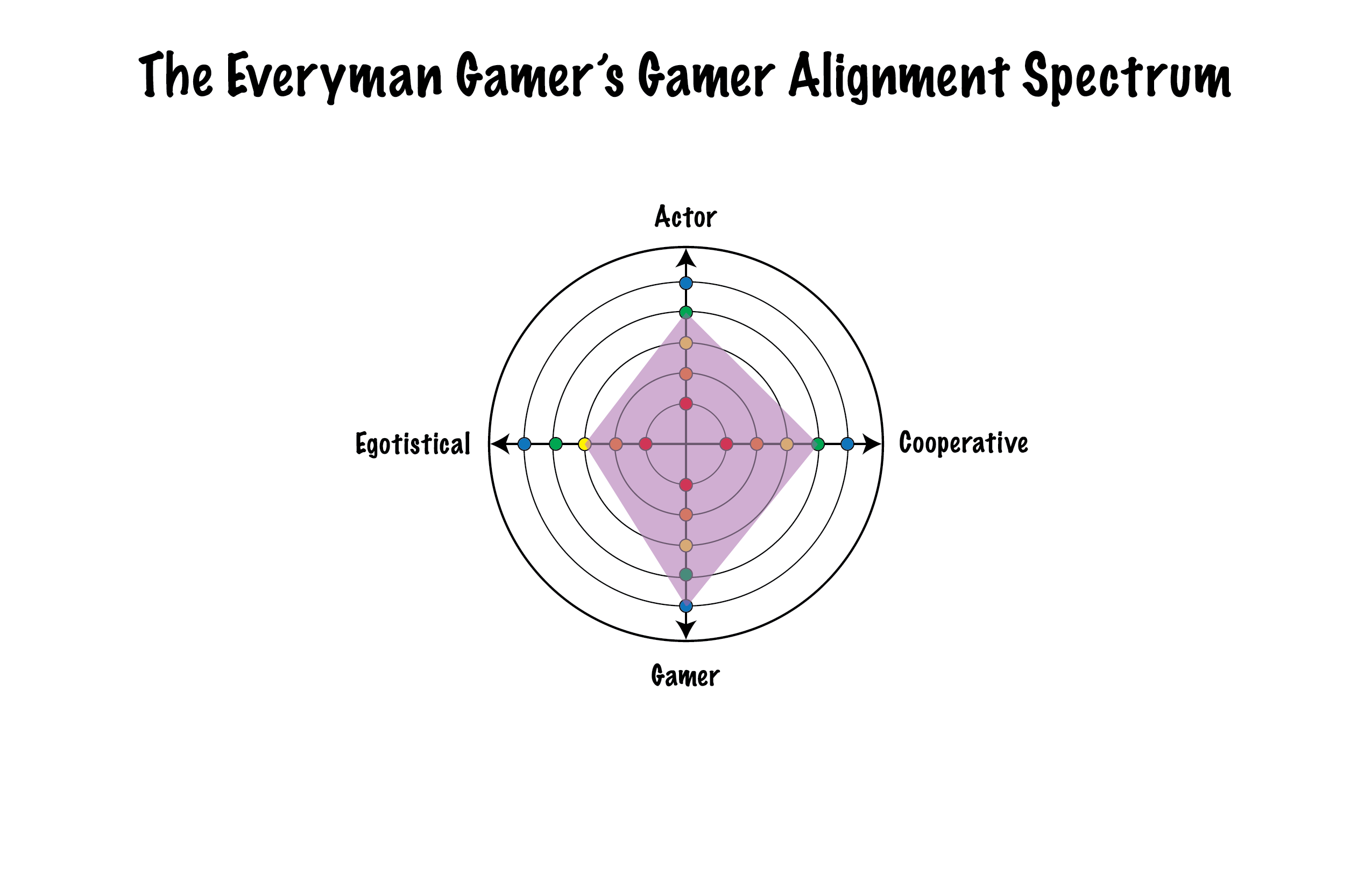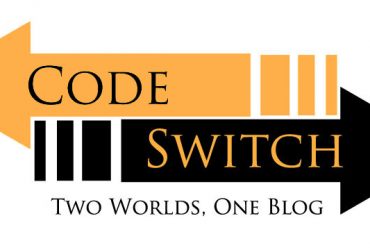Welcome to Guidance, Private Sanctuary’s source for tips and techniques for the Pathfinder Roleplaying Game, written by Everyman Gamer Alexander Augunas. Today, we’re going to be talking about the spectrum of gamer attitudes.
As many of my readers know, teaching is my day job—specifically, I currently work as an instructional assistant in a special education classroom that services students who are on the autistic spectrum. When you are teaching this type of population, one thing that becomes incredibly clear is one simple sentence: the brain is not binary.
Now, when I say “binary,” I mean “X or Y.” “Young or Old.” “Black or White.” “Tall or short.” In fact, very few things in the real world are binary, no matter how much we’d like them to be. Binary is simple. Binary is easy. Binary is also usually stereotypical.
So, what does this have to do with Pathfinder? Well, the other day I found this “Eight Gamer Alignments” chart by someone named Doug. It attempts to break down gamers into simplified “alignments” that are designed around common themes and troupes. I saved said chart and brought it into today’s article to talk about, because I think its missing something important. Something that I myself didn’t talk about when I did my series of articles where I compared gamer personalities to outsider races.
The thing that I didn’t talk about is this—personality is a spectrum.

Binary vs. Spectrum
So, what’s the difference between something that’s binary and something that’s on a spectrum? Binary refers to the idea that there can only be two answers or two points to a given topic, while spectrum refers to the idea that the “points” exist on a near-infinite scale ranging between two extremes.
For example, let’s talk temperature. In a binary system, you might only have two temperatures: hot and cold. A spectrum, on the other hand, would look more like this: sweltering, hot, warm moderate, breeze, cool, chilly, cold, and freezing.
Basically, a spectrum allows us to better classify data and information than a binary system does, because a binary system is designed for one thing and one thing only: simplicity. That’s why a binary system of alignment works in Pathfinder; although it doesn’t stop all arguments, having an easy-to-grasp system makes action and intent relatively easy to comprehend in Pathfinder. Saying, “He’s evil,” is much more direct than saying, “He’s evil with some goodly tendencies when small children are involved, or his life is on the line,” even if the latter example is much more evocative of real-world morality.
Because that’s the basic problem with trying to classify people, REAL people, with a binary system—it ends up creating stereotypes and generalizations. It’s essentially why Batman’s Alignment is a doomed topic of conversation. Batman has seriously conflicting moralities that alter based upon his current situation. He has a basic mantra that he sticks to, but between iterations and different phases of his life, he is willing to negotiate some of his otherwise more stringent values. He’s a much better example of a character who is on an alignment spectrum, like real people (not Pathfinder PCs, but real people) are.
Rewriting the Spectrum
The first thing that we need to do in order to make the Gamer Alignment system a bit more applicable is to alter it from being a binary system to a spectrum. With this in mind, I redesigned our Gamer Alignment Chart into a five-pronged spectrum that takes into account how strongly your behaviors fit into each category. I also renamed the “dickhead” and “reasonable” categories, because “reason implies intelligence, not compassion, and anyone who would use a system like this to insult a specific type of person is probably a dickhead themselves, so we’re dropping that. Instead, we’ll be using “egotistic” and “cooperative.”
So without further delay, let’s take a look at the revised Gamer Alignment System!

Actor Axis
The Actor represents a player’s ability to act in character, their sense of drama, and their involvement within the overarching story of the campaign.
- Red Actor: Little to no investment in the story or its characters, and is involved in the story less than 50% of the time. May feel uncomfortable with roleplaying or think that it’s a waste of time and energy. Sometimes, these players are insecure with their roleplaying ability and choose to opt out of roleplaying rather than “mess up.”
- Orange Actor: Has investment in the story and at least some of its characters, and is involved in the story 60% of the time. Orange Actors sometimes have “moments of clarity” where they exhibit much more involvement or concern in the story then what is typically seen by the other players at the table. Often isn’t great at making a distinct personality, but active attempt is usually seen. Personalities are simple, and sometimes tunnel-visioned around one or two key aspects about the character.
- Yellow Actor: Is invested in the story and most of its characters, and is involved in the story 80% of the time. May not be particularly good at “rolling with the punches” or improving, but is good enough that they’re enjoyable. Is usually okay at creating distinct personalities for characters, but doesn’t maintain those distinct personalities all the time. Personalities have some depth and often have a simple backstory explaining them, but aren’t complex.
- Green Actor: Is invested in the story and most of its characters, and is actively involved in the story 90% of the time. Is decent at rolling with the punches and actively participating, and maintains a distinct personality nearly all the time. Personalities have depth and are the result of a well-thought-out backstory.
- Blue Actor: Highly invested in the story and nearly all of its characters, and is involved in the story more than 90% of the time. Is incredibly flexible at “rolling with the punches” in terms of roleplaying and all characters have distinct personalities with in-depth and well-thought out backstories.
Gamer Axis
The Gamer represents a player’s ability to play the game, their sense for the mechanics and their ability to tactically use that information to overcome the game’s obstacles and challenges.
- Red Gamer: Has little to no understanding of the rules or isn’t concerned with tactical thinking. They know most of the rules that their character uses regularly, but rules and tactics aren’t something they actively think about when they play. They couldn’t care less whether or not they get to use any game mechanics during the course of a session.
- Orange Gamer: Rules aren’t particularly motivating to these players, but they’re capable of tactical thinking when they need it. They know most of the rules that their character uses regularly, but sometimes basic rules elude them if they aren’t relevant to their character. They usually aren’t concerned about whether or not they get to use the game’s mechanics during the course of a session.
- Yellow Gamer: Are adequate at learning and remembering rules of the game, are good at tactical playing. They know the most basic rules and those that their character uses regularly, but sometimes need help with harder rules and aren’t too concerned if they don’t get to use their character’s powers and abilities during the course of a given session.
- Green Gamer: Is strong at learning and remembering the rules of the game, and are strong at tactical playing. They know most of the rules and are able to take their turn and adjucate their actions without too much trouble and look forward to opportunities to use their characters effectively during a session.
- Blue Gamer: Is very strong at learning and remembering the rules of the game, and are strong at tactical playing. They effortlessly remember rules just by looking at the battlefield, and often plan their moves as their fellow players act. Character building and leveling up are strongly motivating to them, and often seek opportunities to show their rules mastery and use their powers and abilities in each session.
Cooperative Axis
The Cooperative Axis represents a player’s ability to cooperate with other players at the table, or actively foster a fun experience for everyone.
- Red Cooperative: This gamer doesn’t care about other people at the table and the fun they’re having, or if they do, they only care so far as to make sure that the gaming group doesn’t disband.
- Orange Considerate: This gamer can be a touch abrasive, and is cooperative more than half of the time during a game session.
- Yellow Considerate: This gamer knows how to play cooperatively and makes a real attempt to be cooperative towards the other players at the table. They are cooperatively at least 75% of the time during a given session, but as cooperative play isn’t intrinsically motivating to them, they’re also prone to trying to do their own thing from time to time.
- Green Considerate: This gamer values the fun that her fellow players have at the table and makes a real effort to elevate others during the game. They think cooperatively and enjoy cooperative play, and are themselves cooperative at least 90% of the time.
- Blue Considerate: This gamer places a heavy value in the fun that others are having at the table, and they actively seek out ways to elevate others during the game. Blue Considerate players often have as much fun, if not more fun, when watching a fellow player succeed then when they themselves succeed, and so cooperating play is very important to them. As a result, you almost never need to wonder if this type of player is cooperative towards others—they just do it and are typically great to be around as a result.
Egotistic Axis
The Egotistic Axis represents the player’s desire to serve themselves—egotistic players aren’t necessarily selfish or unwilling to cooperate, but they are largely concerned with their own enjoyment of the game.
- Red Egotistic: Places very little value in their personal enjoyment or accomplishments in the game. They tend to keep pushing forward and chalk everyone’s contributions to the party as a “group effort,” even their own.
- Orange Egotistic: Is somewhat motivated by their personal enjoyment or accomplishments in the game, but ultimately likes to remember themselves that, “It’s just a game,” and that there will always be other times to have the spotlight.
- Yellow Egotistic: Is motivated by their personal enjoyment or accomplishments in the game. Doesn’t go out of their way to “sneak off” or “solo things” in the game and only remembers their contributions to the party when they were extremely poignant or potent.
- Green Egotistic: Is largely motivated by their personal enjoyment or accomplishments in the game. Sometimes tries to challenge self by “sneaking off” or “trying to solo” manageable bits of the game, and often measures or records their contributions to the party.
- Blue Egotistic: Places a very high value in their personal enjoyment or accomplishments in the game, and actively seeks out ways to extol or further those enjoyments. Often goes out of their way to see what they can do by themselves, and is prone to “sneaking off,” or “trying to solo” things in the game, and will usually measure or record their contributions to the party.
Alex on the Spectrum
So to close out my thoughts on a Spectrum of Gamer Alignment, I thought it would be fun if I did myself. Because you can’t judge others unless you first judge yourself. So, here I go!

Green Actor, Green Cooperative, Blue Gamer, Yellow Egotistical
So, what do you think? How does my version hold up to the original? If you’ve ever gamed with me (or listened to one of my games online), do you think my measurements for myself are accurate? Would you change anything with my spectrum? What do you think YOUR stats would look like? Leave your answers and questions below, and I’ll see you on Friday for a new installment of Iconic Design! Take care.
Alexander “Alex” Augunas has been playing roleplaying games since 2007, which isn’t nearly as long as 90% of his colleagues. Alexander is an active freelancer for the Pathfinder Roleplaying Game and is best known as the author of the Pact Magic Unbound series by Radiance House. Alex is the owner of Everyman Gaming, LLC and is often stylized as the Everyman Gamer in honor of Guidance’s original home. Alex also cohosts the Private Sanctuary Podcast, along with fellow blogger Anthony Li, and you can follow their exploits on Facebook in the 3.5 Private Sanctuary Group, or on Alex’s Twitter, @AlJAug.






